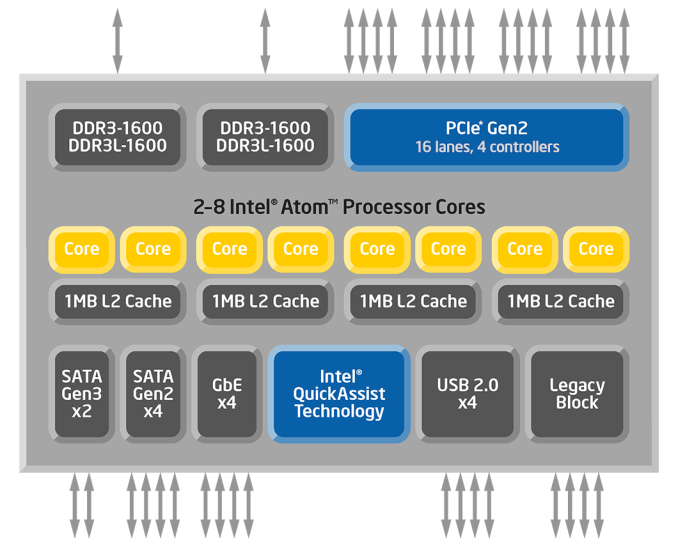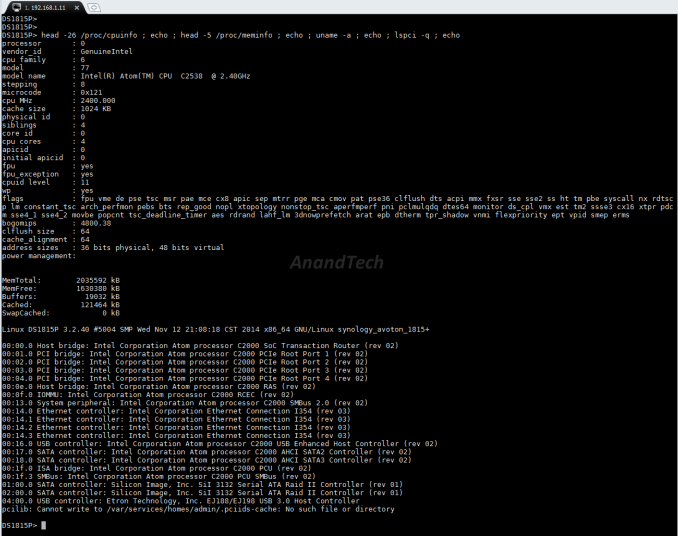
Original Link: https://www.anandtech.com/show/8693/synology-ds1815-8bay-intel-rangeley-smb-nas-review
Synology DS1815+ 8-bay Intel Rangeley SMB NAS Review
by Ganesh T S on November 18, 2014 6:30 AM EST
Introduction and Testbed Setup
Synology started the roll-out of their SMB-targeted NAS units based on Intel's latest Atom platform (Rangeley) in September 2014. We have already looked at the 4-bay DS415+ in detail. Today, the 5-bay DS1515+ and 8-bay DS1815+ versions are being officially launched. As a recap, the Rangeley-based NAS units finally bring about hardware accelerated encryption capabilities to DSM in the desktop tower form factor. A host of other advantages pertaining to the storage subsystem are also provided by Rangeley / Avoton. The SoC being used in the DS1815+ (Intel Atom C2538) is the same as the one being used in the DS415+ and the amount of RAM is also the same (2 GB). The difference is in the number of expansion bays that can be attached to the main unit (2x 5-bay DX513 for the DS1815+ vs. 1x 5-bay DX513 for the DS415+, with some volume expansion restrictions on the latter). The RAM in the DS1815+ can be upgraded (one free slot that can accommodate an extra 4 GB of RAM). Unlike the 100W external adapter in the DS415+, we have an internal 250W PSU in the DS1815+.
The I/O ports on the DS1815+ are based on the DS1813+. Compared to the DS1812+ that we reviewed last year, the DS1813+ (and, by extension, the DS1815+ that we are looking at today) added two extra network ports. Eight drive bays and four GbE network links are backed up by an embedded Linux OS, the DSM, which brings a host of virtualization certifications. All in all, the new Atom platform in DS1815+ seems to present a compelling case over the previous 8-bay units from Synology based on the older Atoms. The specifications of the DS1815+ are provided in the table below.
| Synology DS1815+ Specifications | |
| Processor | Intel Atom C2538 (4C/4T Silvermont x86 Cores @ 2.40 GHz) |
| RAM | 2 GB DDR3 RAM (+ 4GB max. in 2nd slot) |
| Drive Bays | 8x 3.5"/2.5" SATA II / III HDD / SSD (Hot-Swappable) |
| Network Links | 4x 1 GbE |
| External I/O Peripherals | 4x USB 3.0, 2x eSATA |
| Expansion Slots | None |
| VGA / Display Out | None |
| Full Specifications Link | Synology DS1815+ Specifications |
| Price | US $1050 (Amazon) |
In the rest of the review, we will take a look at the Intel Rangeley platform and how the Synology DS1815+ takes advantage of it. This is followed by benchmark numbers for both single and multi-client scenarios across a number of different client platforms as well as access protocols. We have a separate section devoted to the performance of the DS1815+ with encrypted shared folders. Prior to all that, we will take a look at our testbed setup and testing methodology.
Testbed Setup and Testing Methodology
The Synology DS1815+ can take up to eight drives. Users can opt for either JBOD, RAID 0, RAID 1, RAID 5, RAID 6 or RAID 10 configurations. We expect typical usage to be with multiple volumes in a RAID-5 or RAID-6 disk group. However, to keep things consistent across different NAS units, we benchmarked a SHR volume with single disk redundancy (RAID-5). Eight Western Digital WD4000FYYZ RE drives were used as the test disks. Our testbed configuration is outlined below.
| AnandTech NAS Testbed Configuration | |
| Motherboard | Asus Z9PE-D8 WS Dual LGA2011 SSI-EEB |
| CPU | 2 x Intel Xeon E5-2630L |
| Coolers | 2 x Dynatron R17 |
| Memory | G.Skill RipjawsZ F3-12800CL10Q2-64GBZL (8x8GB) CAS 10-10-10-30 |
| OS Drive | OCZ Technology Vertex 4 128GB |
| Secondary Drive | OCZ Technology Vertex 4 128GB |
| Tertiary Drive | OCZ Z-Drive R4 CM88 (1.6TB PCIe SSD) |
| Other Drives | 12 x OCZ Technology Vertex 4 64GB (Offline in the Host OS) |
| Network Cards | 6 x Intel ESA I-340 Quad-GbE Port Network Adapter |
| Chassis | SilverStoneTek Raven RV03 |
| PSU | SilverStoneTek Strider Plus Gold Evolution 850W |
| OS | Windows Server 2008 R2 |
| Network Switch | Netgear ProSafe GSM7352S-200 |
The above testbed runs 25 Windows 7 VMs simultaneously, each with a dedicated 1 Gbps network interface. This simulates a real-life workload of up to 25 clients for the NAS being evaluated. All the VMs connect to the network switch to which the NAS is also connected (with link aggregation, as applicable). The VMs generate the NAS traffic for performance evaluation.
Thank You!
We thank the following companies for helping us out with our NAS testbed:
- Thanks to Intel for the Xeon E5-2630L CPUs and the ESA I-340 quad port network adapters
- Thanks to Asus for the Z9PE-D8 WS dual LGA 2011 workstation motherboard
- Thanks to Dynatron for the R17 coolers
- Thanks to G.Skill for the RipjawsZ 64GB DDR3 DRAM kit
- Thanks to OCZ Technology for the two 128GB Vertex 4 SSDs, twelve 64GB Vertex 4 SSDs and the OCZ Z-Drive R4 CM88
- Thanks to SilverStone for the Raven RV03 chassis and the 850W Strider Gold Evolution PSU
- Thanks to Netgear for the ProSafe GSM7352S-200 L3 48-port Gigabit Switch with 10 GbE capabilities.
- Thanks to Western Digital for the eight WD RE hard drives (WD4000FYYZ) to use in the NAS under test.
Platform Analysis
The higher end segment of the SOHO / SMB NAS market uses Intel's Core-series and Xeon CPUs to deliver the required performance while supporting a large number of drive bays (typically more than 8, in a rackmount form-factor). Over the last four years or so, Intel's play in the other tiers has been mainly with its Atom CPU lineup. Back in 2010, Intel pushed the 45 nm Atom D410 / D510 / D525 for NAS units. In 2012, it was the 32 nm Atoms, the D2550 and D2700. All of these were based on the in-order Bonnell microarchitecture which was fast becoming dated compared to the advancements being made by the ARM SoC vendors. In moving from 32nm to 22nm, Intel completely revamped the microarchitecture for their Atom cores. Bonnell was replaced by Silvermont, bringing out of order execution and other improvements into the picture. Silvermont's applicability to a variety of power profiles meant that there were multiple product lines that ended up using the CPU cores. Bay Trail is proving very effective in tablets and also makes up QNAP's TS-x51 and TS-x53 Pro NAS series. Merrifield and Moorefield are trying to break into smartphones, but it is Avoton and Rangeley that are more relevant to the storage appliances market.
The different product lines integrate different I/O around the Silvermont cores depending on the target market. Avoton is meant for microservers and cloud storage platforms, while Rangeley is meant for communication and network infrastructure. Both of them integrate similar I/O around the cores, but the Rangeley parts have an updated crypto engine. The block diagram of a generic Rangeley part is provided below.
There is a wealth of I/O (2x SATA Gen 3, 4x SATA Gen 2 and up to 16 PCIe 2.0 lanes) for the storage subsystem, and the parts also support up to 4x 2.5 Gbps network links. From the viewpoint of the Synology DS1815+, the above block diagram should be considered in the context of the information gleaned via SSH access to the unit.
The DS1815+ uses the Intel Atom C2538 SoC which has four Silvermont cores running at 2.4 GHz. It is backed up by 2 GB of DRAM. The Atom C2538 has 16 PCIe 2.0 lanes. The Silicon Image SiI3132 PCIe to 2-port SATA II host controller uses a single PCIe 2.0 lane on the host side. There are two of them using up two PCIe 2.0 lanes in total. Unlike the DS415+ in which the USB 3.0 ports were provided by the Etron EJ168 USB 3.0 host controller, the DS1815+ uses the Etron EJ198. This USB 3.0 host controller uses two PCIe lanes to enable the four USB 3.0 ports found on the rear side of the unit. The four Ethernet controllers are all based on the Intel I354. Despite being 2.5G-capable, the transceivers they are connected to make them GbE ports.
The more interesting hardware aspect is the absence of any PCIe to SATA bridges for the internal ports. Given that the C2538 has only a total of six SATA ports (2x SATA III and 4x SATA II) and there are no bridges in the SSH report, it can be inferred that a port multipler (1x SATA host to 2x SATA device) such as the ASMedia ASM1092 must be in use. However, without opening up the unit (which we haven't done yet, given our limited time to bring out the review), this can't be confirmed.
On the software front, the DS1815+ runs Linux (kernel version 3.2.40). We have covered DSM 5.0's setup and usage impressions in our recent DS214play and DS414j reviews. There is not much point in rehashing the same excellent setup and usage experience. That said, with the ioSafe 1513+, we also started looking at iSCSI support in NAS units. We will be looking at that aspect in this review also.
Single Client Performance - CIFS & iSCSI on Windows
The single client CIFS and iSCSI performance of the Synology DS1815+ was evaluated on the Windows platforms using Intel NASPT and our standard robocopy benchmark. This was run from one of the virtual machines in our NAS testbed. All data for the robocopy benchmark on the client side was put in a RAM disk (created using OSFMount) to ensure that the client's storage system shortcomings wouldn't affect the benchmark results. It must be noted that all the shares / iSCSI LUNs are created in a RAID-5 volume. The DS1815+ manages to compare favorably against the two other 8-bay solutions we have evaluated before. The benchmark numbers are provided in the graph below.
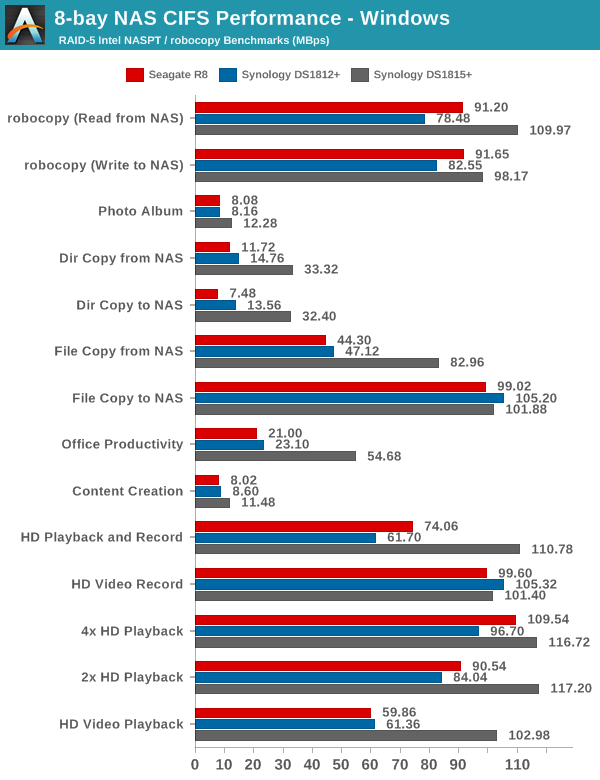
We created a 250 GB iSCSI LUN / target and mapped it on to a Windows VM in our testbed. The same NASPT benchmarks were run and the results are presented below. The observations we had in the CIFS subsection above hold true here too.
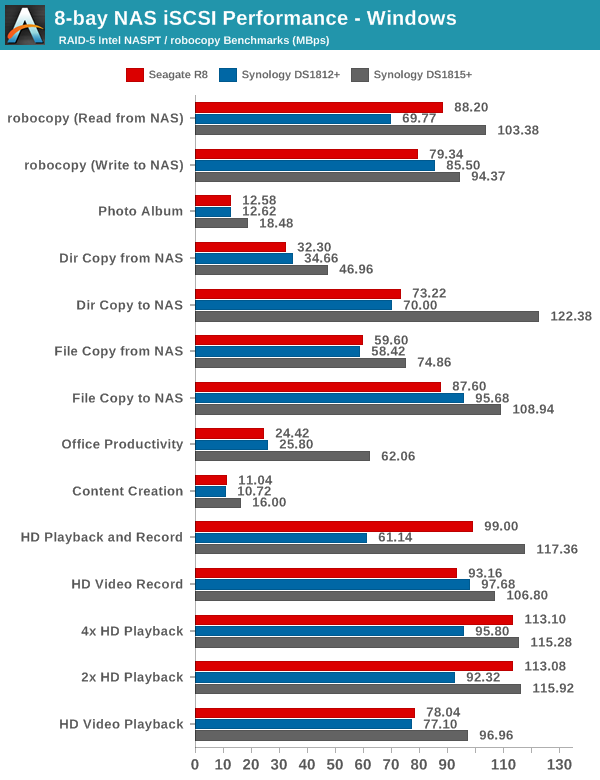
These numbers are only to be expected - the Seagate R8 is based on the Celeron G1610T, a 2C/2T processor running at a lower frequency (compared to the 4C/4T solution in the DS1815+). In addition, DSM is much more mature compared to Seagate's NAS OS back when the R8 was reviewed. The DS1812+, on the other hand, is a Atom D2700 NAS. Evaluation was done with a older version of DSM and, obviously, the newer hardware brings better performance.
Single Client Performance - CIFS & NFS on Linux
A CentOS 6.2 virtual machine was used to evaluate NFS and CIFS performance of the NAS when accessed from a Linux client. We chose IOZone as the benchmark for this case. In order to standardize the testing across multiple NAS units, we mount the CIFS and NFS shares during startup with the following /etc/fstab entries.
//<NAS_IP>/PATH_TO_SMB_SHARE /PATH_TO_LOCAL_MOUNT_FOLDER cifs rw,username=guest,password= 0 0
<NAS_IP>:/PATH_TO_NFS_SHARE /PATH_TO_LOCAL_MOUNT_FOLDER nfs rw,relatime,vers=3,rsize=32768,wsize=32768,namlen=255,hard,proto=tcp,timeo=600,retrans=2, sec=sys,mountaddr <NAS_IP>,mountvers=3,mountproto=udp,local_lock=none,addr=<NAS_IP> 0 0
The following IOZone command was used to benchmark the CIFS share:
IOZone -aczR -g 2097152 -U /PATH_TO_LOCAL_CIFS_MOUNT -f /PATH_TO_LOCAL_CIFS_MOUNT/testfile -b <NAS_NAME>_CIFS_EXCEL_BIN.xls > <NAS_NAME>_CIFS_CSV.csv
IOZone provides benchmark numbers for a multitude of access scenarios with varying file sizes and record lengths. Some of these are very susceptible to caching effects on the client side. This is evident in some of the graphs in the gallery below.
Readers interested in the hard numbers can refer to the CSV program output here.
The NFS share was also benchmarked in a similar manner with the following command:
IOZone -aczR -g 2097152 -U /nfs_test_mount/ -f /nfs_test_mount/testfile -b <NAS_NAME>_NFS_EXCEL_BIN.xls > <NAS_NAME>_NFS_CSV.csv
The IOZone CSV output can be found here for those interested in the exact numbers.
A summary of the bandwidth numbers for various tests averaged across all file and record sizes is provided in the table below. As noted previously, some of these numbers are skewed by caching effects. A reference to the actual CSV outputs linked above make the entries affected by this effect obvious.
| Synology DS1815+ - Linux Client Performance (MBps) | ||
| IOZone Test | CIFS | NFS |
| Init Write | 85 | 79 |
| Re-Write | 83 | 79 |
| Read | 49 | 115 |
| Re-Read | 51 | 114 |
| Random Read | 30 | 66 |
| Random Write | 80 | 78 |
| Backward Read | 30 | 53 |
| Record Re-Write | 50 | 1681* |
| Stride Read | 46 | 116 |
| File Write | 83 | 79 |
| File Re-Write | 83 | 80 |
| File Read | 33 | 94 |
| File Re-Read | 36 | 95 |
| *: Benchmark number skewed due to caching effect | ||
Multi-Client Performance - CIFS on Windows
We put the Synology DS1815+ through some IOMeter tests with a CIFS share being accessed from up to 25 VMs simultaneously. The following four graphs show the total available bandwidth and the average response time while being subject to different types of workloads through IOMeter. The tool also reports various other metrics of interest such as maximum response time, read and write IOPS, separate read and write bandwidth figures etc. Some of the interesting aspects from our IOMeter benchmarking run can be found here.
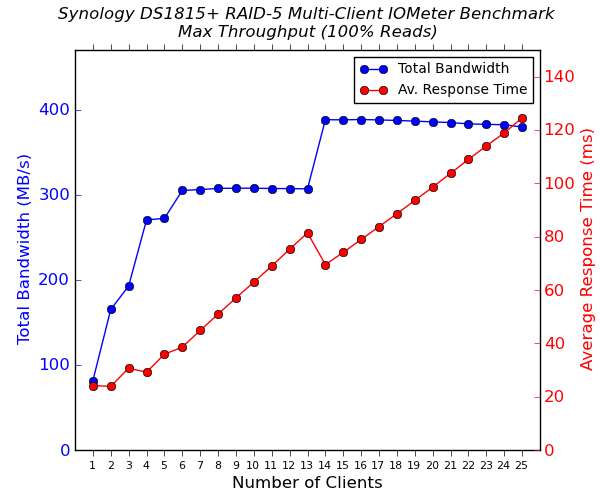
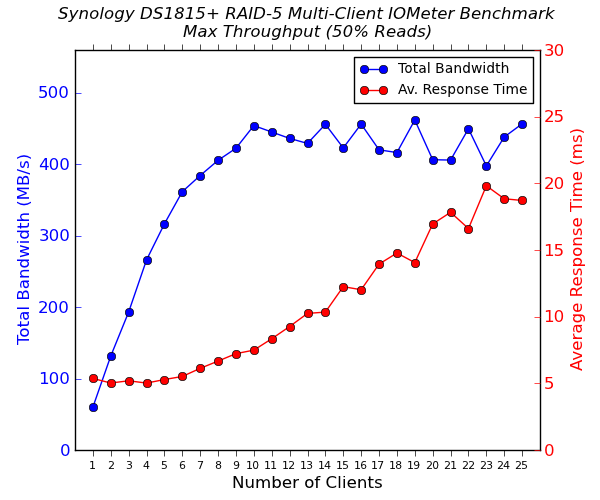
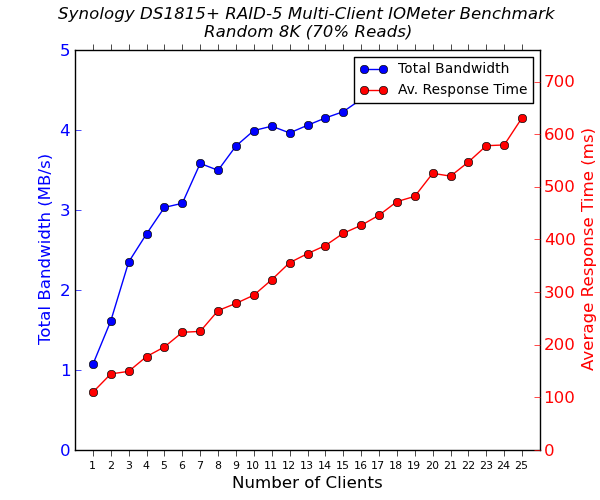
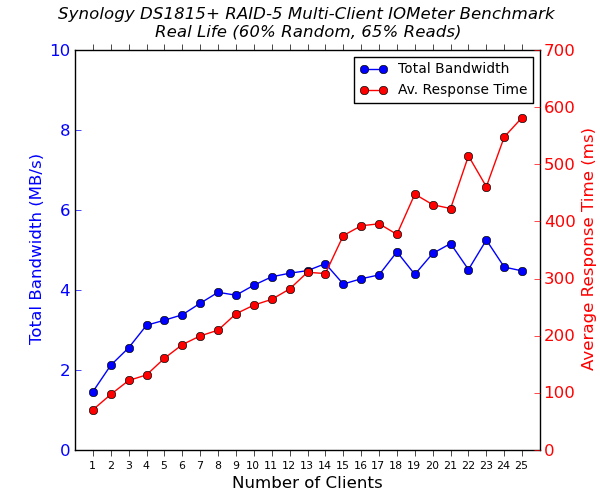
At the outset, it must be said that the two extra network ports on the DS1815+ (compared to the Seagate R8 and the DS1812+) make an apples-to-apples comparison difficult. In sequential workloads, the extra bandwidth delivers better throughput numbers. Average response times are also much better for the DS1815+. However, in the real-life and random 8K workloads, the performance of the DS1815+ and DS1812+ don't show much difference. The Seagate R8 also manages to deliver better results in a number of scenarios for this workload. That said, the average response times are excellent and the maximum response times are kept well under control.
Multi-Client iSCSI Evaluation
As virtualization becomes more and more popular even in home / power user settings, the importance of the iSCSI feature set of any COTS NAS can't be overstated. Starting with our ioSafe 1513+ review, we have started devoting a separate section (in the reviews of NAS units targeting SMBs and SMEs) to the evaluation of iSCSI performance. Since we have already looked at the way iSCSI LUNs are implemented in DSM in the ioSafe 1513+ review, it won't be discussed in detail.
We evaluated the performance of the DS1815+ with file-based LUNs as well as configuring a RAID-5 disk group in multiple LUNs mode and single LUN mode. The standard IOMeter benchmarks that we used for multi-client CIFS evaluation were utilized for iSCSI evaluation also. The main difference to note is that the CIFS evaluation was performed on a mounted network share, while the iSCSI evaluation was done on a 'clean physical disk' (from the viewpoint of the virtual machine).
Performance Numbers
The four IOMeter traces were run on the physical disk manifested by mapping the iSCSI target on each VM. The benchmarking started with one VM accessing the NAS. The number of VMs simultaneously playing out the trace was incremented one by one till we had all 25 VMs in the fray. Detailed listings of the IOMeter benchmark numbers (including IOPS and maximum response times) for each configuration are linked below:
- Synology DS1815+ - iSCSI LUN (Regular Files) - 8x 4 TB / RAID-5 / 4x 1G
- Synology DS1815+ - Multiple LUNs on RAID - 8x 4 TB / RAID-5 / 4x 1G
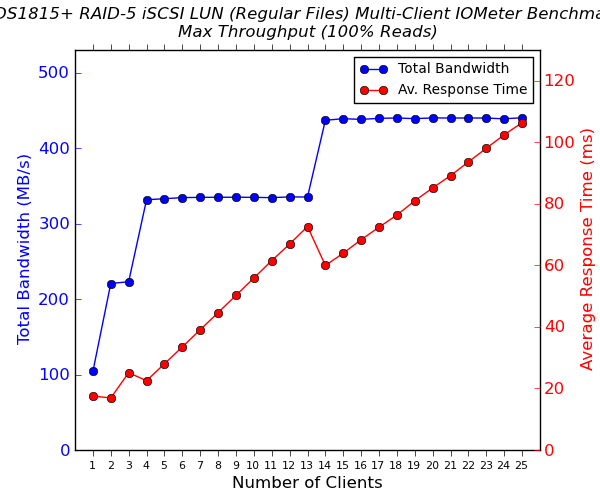

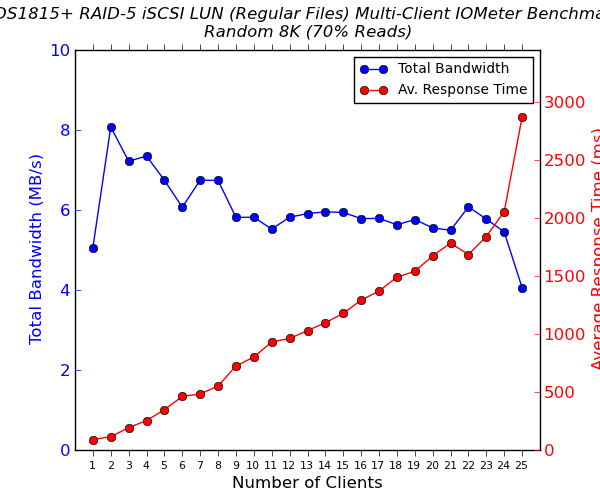
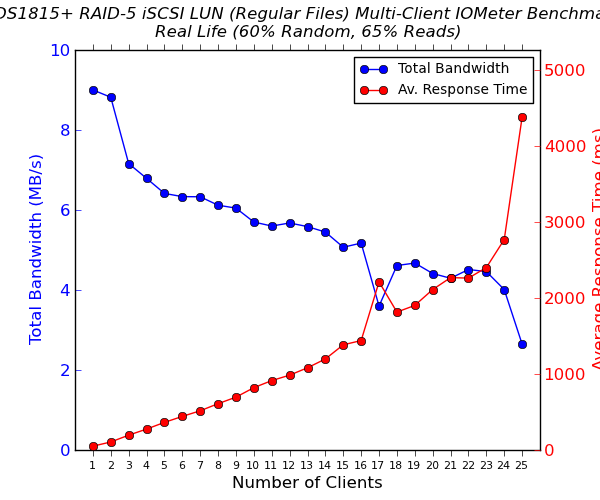
Since the number of NAS units that we have put through this evaluation is limited, we have a couple of 4-bay NAS units in the comparison drop-downs above. Unfortunately, we have no graphs for apples-to-apples comparison. That said, we do see the 'single LUN on RAID' mode delivering the best performance. For some strange reason, the multiple LUNs on RAID configuration is never able to take advantage of the bonded network ports. Even the simultaneous multi-client sequential reads test always stay below 125 MBps.
File-based LUNs give maximum flexibility - thin provisioning, support for VMWare VAAI and Windows ODX. The latest versions of DSM have improved on the iSCSI feature set quite a bit. Synology's competitors have a bit of catching up to do in the iSCSI feature set area.
As more NAS units are processed, we hope this section will provide readers with a way to quickly get an idea of the competitive performance of a particular NAS unit when it comes to iSCSI support.
Encryption Support Evaluation
Consumers looking for encryption capabilities can opt to encrypt a iSCSI share with TrueCrypt or some in-built encryption mechanism in the client OS. However, if requirements dictate that the data must be shared across multiple users / computers, relying on encryption in the NAS is the best way to move forward. Most NAS vendors use the industry-standard 256-bit AES encryption algorithm. One approach is to encrypt only a particular shared folder while the other approach is to encrypt the full volume. Synology supports only folder-level encryption for now in DSM.
On the hardware side, encryption support can be in the form of specialized hardware blocks in the SoC (common in ARM / PowerPC based NAS units). In x86-based systems, accelerated encryption support is dependent on whether the AES-NI instruction is available on the host CPU. One of the most attractive features of the Intel Rangeley platform / Silvermont cores is full hardware acceleration for all essential cryptography functions. The results, as you can see below, are consistent across all evaluated scenarios. The penalty compared to unencrypted shares is non-existent.
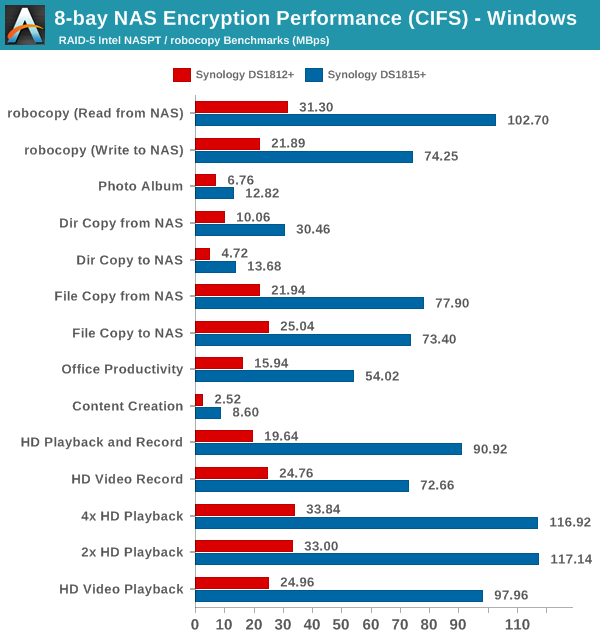
The above graph shows why AES-NI is essential for users looking to encrypt shared folders / volumes in NAS units
Miscellaneous Aspects and Final Words
In order to keep testing consistent across all 8-bay units, we performed all our expansion / rebuild testing as well as power consumption evaluation with the unit configured in RAID-5. The disks used for benchmarking (Western Digital WD4000FYYZ) were also used in this section. The table below presents the average power consumption of the unit as well as time taken for various RAID-related activities.
| Synology DS1815+ RAID Expansion and Rebuild / Power Consumption | ||
| Activity | Duration (HH:MM:SS) | Avg. Power (W) |
| Single Disk Init | 0:10:42 | 32.14 W |
| JBOD to RAID-1 Migration | 11:17:58 | 42.34 W |
| RAID-1 (2D) to RAID-5 (3D) Migration | 35:53:15 | 51.68 W |
| RAID-5 (3D) to RAID-5 (4D) Expansion | 25:1:4 | 62.48 W |
| RAID-5 (4D) to RAID-5 (5D) Expansion | 23:32:53 | 73.78 W |
| RAID-5 (5D) to RAID-5 (6D) Expansion | 23:6:12 | 84.07 W |
| RAID-5 (6D) to RAID-5 (7D) Expansion | 24:28:29 | 94.58 W |
| RAID-5 (7D) to RAID-5 (8D) Expansion | 27:7:26 | 104.72 W |
| RAID-5 (8D) Rebuild | 14:21:12 | 103.44 W |
The graphs below show the power consumption and rebuild duration when repairing a RAID-5 volume for the various 8-bay NAS units that have been evaluated before.

Even though the DS1815+ is not as power efficient as the DS1812+, the unit turns out to be better by a huge margin thanks to the cut-down in the rebuild duration. That said, it does look like Synology can optimize RAID rebuild and expansion durations further.
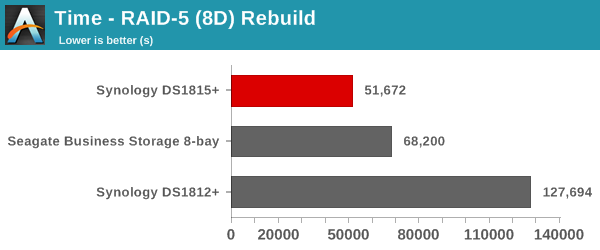
Concluding Remarks
The SMB / SOHO / prosumer COTS NAS market is interestingly poised. With the previous generation Atom platforms, NAS vendors had to differentiate themselves with the software. However, with their 22nm silicon, Intel has provided them with multiple options. We have already looked at QNAP using Bay Trail-D with extra focus on the multimedia transcoding and virtualization aspects. Asustor has opted to go the Haswell route, with a Core i3 CPU for the 70-series. With the DSx15+ series, Synology has placed its bets on the Intel Rangeley platform.
The new Rangeley platform has made up for the drawbacks of the previous generation x86 platforms at this price point. Equipped with the Atom C2538, the DS1815+ excels in three areas: multi-client performance, encryption capabilities and power efficiency. Synology's DSM is quite mature and it has no problems in bringing out the potential of Intel's Rangeley for the NAS market. The latest version of DSM brings deeper cloud integration (more cloud vendors supported for backup), better sync control, an advanced multi-platform note-taking solution in Note Stations / DS Note and improved security features (such as digital signing for packages). For the SMB market that Synology is targeting with the DS1815+, DSM 5.1 also brings SSD caching to high-availability clusters, VMware VAAI for NFS (in addition to the already existing iSCSI support) and scheduled iSCSI LUN snapshots.
Multi-client performance in terms of average response times is better because of the highly integrated I/O compared to other solutions which use bridge chips and have bottlenecks in connecting to the CPU. The appearance of AES-NI in the Atom-class SoCs has finally delivered power efficient encryption capabilities. Obviously, the 22 nm fabrication process as well as tight I/O integration greatly help in reducing the power consumption of the platform compared to other solutions in the market.
The above advantages aside, there are certain areas where Synology could improve:
- The DS1815+ needs to ship with 4 GB of RAM by default. Users running multiple apps would benefit tremendously.
- Even though the iSCSI feature set is quite advanced and ahead of the competitors, performance for the 'multiple LUNs on RAID' case could do with some improvement
- In terms of hardware / chassis design, a USB port (even 2.0 would suffice) on the front would be nice to have.
At $1050 for a diskless unit, the pricing is not unreasonable (given the premiums usually associated with Synology units). The Atom C2538 is one of the more powerful Rangeley SoCs and it helps the DS1815+ pack quite a punch for the SMB / SOHO market. We will shortly be reviewing a couple of 8-bay NAS units from other vendors. They will help us get a better understanding of where the DS1815+ stands when contemporary NAS units are taken into consideration.







